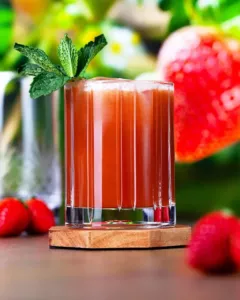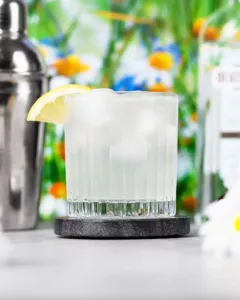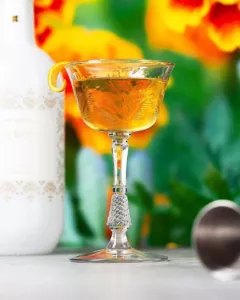This post contains affiliate links. See my disclosure policy here.
Cocktail History
The Sazerac is a classic cocktail that was created by bartender Leon Lamothe in New Orleans, Louisiana in the early 1800s. It was made to use with Peychaud’s Creole bitters, a gentian-infused cordial that was invented by an apothecary in the French Quarter named Antoine Amedée Peychaud. He originally sold his bitters as a medicinal tonic, but they became a popular ingredient in alcoholic drinks by the mid-1800s. This recipe, traditionally made with Sazerac rye, sugar, Peychaud’s Creole Bitters, absinthe, and citrus, is now the most famous, so much that it eventually became the official drink of New Orleans.
Cocktail Ingredients
To make this cocktail, you’ll need the following ingredients:
Rye: This is a type of whiskey made with at least 51% rye grain, malted barley, corn, and water. I used Sazerac Rye 18-Year-Old Kentucky Straight Rye Whiskey.
Simple Syrup: This is a sweetener made with white sugar and water. I used this stovetop recipe.
Peychaud’s Creole Bitters: This is a food product made with gentian root, anise, medicinal herbs, sugar, and alcohol.
Absinthe: This is a spirit made with anise, wormwood, fennel, botanicals, and alcohol. I used Great Lakes Distillery Amerique 1912 Absinthe Verte.
Lemon Twist: This is the peel of a lemon that has been twisted into a corkscrew shape.
Bartending Tools
To make this cocktail, you’ll need the following bar tools:
Atomizer: This is use to rinse the glass with an ingredient. I used the True Martini Atomizer.
Jigger: This is used to measure and pour ingredients. I used the Japanese jigger from the A Bar Above 14-Piece Silver Bar Set.
Mixing Glass: This is used to hold the ingredients while they’re being stirred. I used the Viski 17 oz Cocktail Mixing Glass.
Bar Spoon: This is used to stir ingredients. I used the Barfly Stainless Steel Teardrop Bar Spoon.
Julep Strainer: This is used to strain out ice and solid ingredients after the cocktail is stirred. I used the A Bar Above Julep Strainer.
Peeler: This is used to remove the garnish peel from the citrus. I used the OXO Good Grips 2-Piece Peeler Set.
This post contains affiliate links, meaning we make a small commission each time you purchase a product using our links. Product images sourced from Amazon Product Advertising API. Amazon affiliate links last updated on 2025-07-02.

Tasting Notes
This cocktail has the following flavor profile:
• Appearance: Vibrant orange-red color
• Aroma: Absinthe, spices, and a hint of citrus
• Taste: Spiced whiskey flavor rounded out with unique Creole herbs
• Finish: Distinct anise notes
Kendall’s Rating: ⭐⭐
Kendall’s Take: “I’ve come around to liking rye after starting my whiskey tasting journey with bourbon like most people, but I admit, I didn’t love it mixed with the Creole bitters. I also don’t care for absinthe, so since it mixes all three, I found the Sazerac was just too bitter and dry for my palate. I honestly couldn’t drink more than a couple of sips.”
Recipe
This cocktail recipe was adapted from The Art of Vintage Cocktails by Stephanie Rosenbaum.
This post contains affiliate links, meaning we make a small commission each time you purchase a product using our links. Product images sourced from Amazon Product Advertising API. Amazon affiliate links last updated on 2025-07-02.
Sazerac
The Sazerac is a classic cocktail that was created by bartender Leon Lamothe in New Orleans, Louisiana in the early 1800s. It was made to use with Peychaud’s Creole bitters, a gentian-infused cordial that was invented by an apothecary in the French Quarter named Antoine Amedée Peychaud. He originally sold his bitters as a medicinal tonic, but they became a popular ingredient in alcoholic drinks by the mid-1800s. This recipe, traditionally made with Sazerac rye, sugar, Peychaud’s Creole Bitters, absinthe, and citrus, is now the most famous, so much that it eventually became the official drink of New Orleans.

Ingredients
Method
-
Rinse the inside of a lowball glass with absinthe.
-
Add rye, bitters, simple syrup, and cubed ice to a mixing glass.
-
Stir for 30-45 seconds.
-
Strain into absinthe-rinsed glass.
-
Garnish with lemon twist.

























